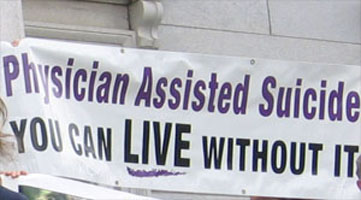King Filip-Philippe of Belgium recently signed a law permitting doctors to euthanize terminally ill children. In late January, a state court judge in New Mexico enjoined the prosecution of any physician for providing “physician aid in dying” to a “mentally-competent, terminally-ill individual.” While some may feel these two events are worlds apart—physicians directly killing terminally ill children versus physicians prescribing life-ending medication to “competent,” terminally ill adults[i]—they are wrong; the road from New Mexico to Belgium presents a very real slippery slope towards an even deadlier end.
Legal euthanasia began in Belgium in 2002.[ii] Unlike the Netherlands, where “consenting” children can be euthanized as young as twelve with parental consent, for over a decade Belgium’s law was restricted to incurably ill adults with “unbearable physical or mental suffering.” Now, with the recent change, Belgium’s law is more extreme than the Netherlands’—terminally ill children of any age can request to be euthanized.
 Proponents argue that doctors will only euthanize children who have no other recourse for their pain. However, the application of the Belgian law to adults demonstrates restrictions on killing will not be maintained (e.g., in 2012 43-year-old deaf twins were euthanized because an incurable but nonfatal genetic disorder was threatening their independence).
Proponents argue that doctors will only euthanize children who have no other recourse for their pain. However, the application of the Belgian law to adults demonstrates restrictions on killing will not be maintained (e.g., in 2012 43-year-old deaf twins were euthanized because an incurable but nonfatal genetic disorder was threatening their independence).
On this side of the Atlantic, the new court decision in New Mexico prevents the prosecution of “physician aid in dying,” a euphemism for physician-assisted suicide. In her opinion, Judge Nan G. Nash distinguished “physician aid in dying”—which she deemed constitutionally protected under New Mexico’s Constitution as a fundamental right—from other forms of assisted suicide illegal under New Mexico’s law. New Mexico’s statutes and common law do not make this distinction, a fact acknowledged by Judge Nash. However, instead of giving deference to the legislature, Judge Nash characterized “physician aid in dying” as a fundamental right that cannot be prohibited by legislation.
Unfortunately, New Mexico does not stand alone in the U.S. in permitting assisted suicide. The Montana Supreme Court issued a decision in 2009 effectively legalizing physician-assisted suicide by permitting a defense to prosecution for it. The practice is statutorily permitted in Oregon, Vermont, and Washington. Also, at least seven states are considering legislation to legalize it this year.[iii]
While doctors are not permitted to administer life-ending drugs to patients in any U.S. jurisdiction, the implications for vulnerable Americans are the same regardless of who administers the lethal dose. Just as Belgium now permits the use of euthanasia to end the lives of adults with non-terminal conditions and has made euthanasia available to minors, physician-assisted suicide is very likely to be twisted in an ever more “permissive” way where legalized.
None of the reasons frequently cited by patients requesting physician-assisted suicide—a fear of loss of autonomy or dignity and a decreasing ability to participate in activities that make life enjoyable—are unique to terminally ill patients. It is only a matter of time before individuals who are not terminally ill (but could be in greater pain than a terminally ill patient) or who cannot self-administer lethal drugs will sue for the “right” to assisted suicide. As a professor at the Belgian University of Ghent who critiqued her country’s euthanasia law before it was amended, put it: “senseless suffering of minors may be as horrible as that of adults.”[iv]
Note, further, that whether suffering is “senseless” is being judged by a third-party (the professor). This points to another problem. Doctors will begin to view the same kind of suffering in other patients as worthy of the same treatment (i.e., to be ended by death). Thus, whether or not the patient asks for suicide, the doctors will begin to administer it. This is precisely what has happened in the Netherlands.
For all these reasons, it has never been more critical to speak out against assisted suicide and in support of vulnerable Americans. If the availability of physician-assisted suicide for “terminally ill” adults continues to spread across our country, odds are that state courts will one day “find” expansive rights to “aid in dying” for other constituencies as well—even children.[v] The road from Belgium to New Mexico will prove to be short indeed.
[i] For additional information on dangers posed by assisted suicide, please see Preserving Human Dignity at the End of Life, Defending Life 2013, available at https://www.aul.org/wp-content/uploads/2013/04/07-End-of-Life.pdf.
[ii] Euthanasia was legalized in The Netherlands in 2002, and Luxembourg in 2008. Switzerland permits assisted suicide and attracts “suicide tourism.”
[iii] Connecticut, Hawaii, Kansas, Massachusetts, New Hampshire, New Jersey, and Pennsylvania. Maryland is considering whether to commission a study on legalizing the practice, and North Carolina is considering legislation to prohibit assisted suicide.
[iv] E. Vermeersch, The Belgian Law on Euthanasia: The Historical and Ethical Background, Acta chir belg, 2002, 102, 394-397.
[v] The United States Supreme Court held in 1997 that there is no federal constitutional right to assisted suicide. Washington v. Glucksberg, 521 U.S. 702 (1997); Vacco v. Quill, 521 U.S. 793 (1997).







